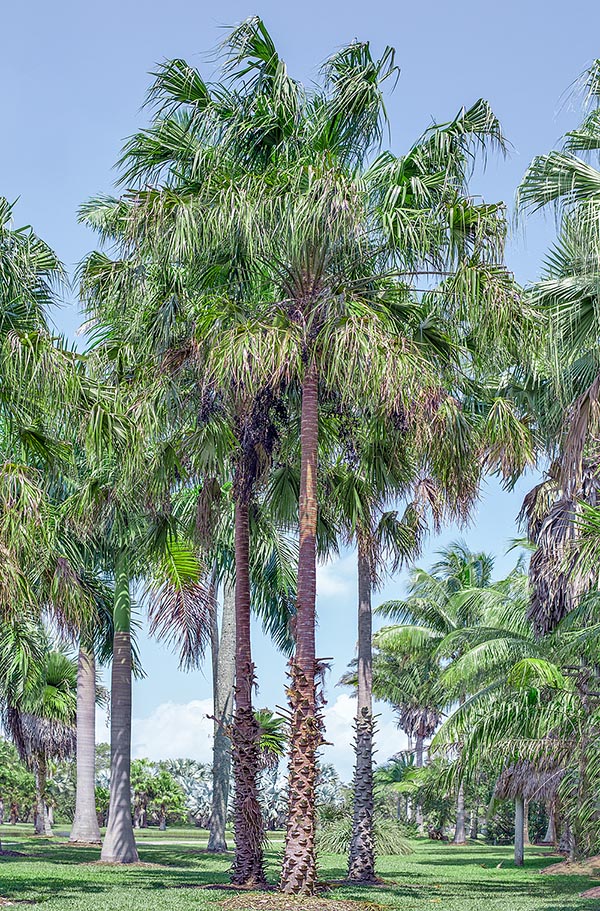Family : Arecaceae

Text © Pietro Puccio

English translation by Mario Beltramini
The species is native to Australia (Northern Territory and Queensland) and to southern New Guinea where it lives in the rainy and swampy forests, on the edges of the mangroves, of the lagoons and of the water streams, from the sea level up to about 100 m of altitude.
The genus was dedicated to Patrick Murray, Baron of Livingston, who destined in 1670 his collection and his garden to botanical garden, later on become the present ‘Royal Botanic Garden Edinburgh’; the species is honoured to the English botanist George Bentham (1800-1884).
Common names: Bentham’s fan palm, Bentham’s fountain palm, swamp cabbage palm (English).
The Livistona benthamii F.M.Bailey (1902) is a monoecious species with hermaphroditic flowers, solitary, with erect stem, 16-20 m tall and of 30-40 cm of diameter at the base, that gradually reduces to 14-18 cm of diameter at about 3 m from the soil, vertically fissured, of pale brown colour with the annular traces of the foliar scars.

Monoecious, even 20 m tall, the Livistona benthamii is native to Australia and to New Guinea. It well adapts in cultivation to the Mediterranean climate. The vegetative apex is edible but causes the death of the plant © Giuseppe Mazza
In the lower part of the stem, for a height of 4-6 m, remain for long time the stumps of the petioles, up to 50-60 cm long, arranged almost horizontally.
The leaves are costapalmate, corrugated, almost circular, 0,8-1,5 m long, of intense green colour and glossy above, slightly paler below, divided in 60-80 segments, 2,5-3 cm broad, united at the base for about 1/3-1/4 of their length, the free part is in its turn divided up to about the half in two linear-lanceolate segments with acute apex slightly diverging and drooping.
The petioles, 1,4-2 m long and 1-2 cm broad, of pale green colour but when close to the base where they display reddish brown hues, are provided in the lowest half of blackish brown spines irregularly arranged and variously curved, of variable length up to 1 cm, almost unarmed in the remaining part; the foliar base falls apart for a good part in a fibrous mass surrounding the stem.
Inflorescences between the leaves (interfoliar), of less long or equal length than that of the petioles, of cream white to yellowish colour, with ramifications of second order and several rachillae, of various length up to about 12 cm, with tiny sessile hermaphroditic flowers, solitary or in groups of 2-3, with 6 stamens united at the base and 3 carpels free at the base and united to the apex forming a unique style with trilobate stigma.
It has been noted that in the populations in nature are present plants fructifying and others not, even if no differences between the flowers are found, this might lead to think to a certain dioecious “de facto” behaviour worthy of a further study. Obovoid to pyriform fruits, 0,9-1,1 cm long and of about 1 cm of diameter, blackish when ripe, containing only one globose seed, of about 0,8 cm of diameter, of dark brown colour.
It reproduces by seed, previously kept in water for three days, in organic draining loam maintained humid at the temperature of 26-28 °C, with germination times from 1 to 4 months.
Similar in appearance to the more known and diffused Livistona australis and Livistona decora, but with more contained dimensions, a thicker foliage and the characteristic long residues of the petioles in the lowest part of the stem, unless shortened in nature by cyclones or fire and manually in cultivation for safety reasons due to the spines.
Despite coming from humid tropical zones, it has proved adaptable to the warm temperate climate like that of Mediterranean type, where it can resist, when adult, to temperatures up to about -3 °C, if exceptional and short lasting. It requires partial shading during the juvenile phase, then even full sun, and adapts to various types of soil, slightly acidic to slightly alkaline, even if it prefers those rich of organic substance maintained almost constantly humid. It bears moderately the saline sprays and short periods of drought, but gets advantage from regular watering in the climates having long warm and dry summers.
The young plants display leaves deeply incised with thin segments, particularly attractive, and are excellent subject to cultivate in pot for the decoration of luminous spaces. The vegetative apex is edible (but causes the death of the plant) and was consumed in the past by the Aborigines as vegetable.
Synonyms: Livistona holtzei Becc. (1921); Livistona melanocarpa Burret (1939).
→ For general notions about ARECACEAE please click here.
